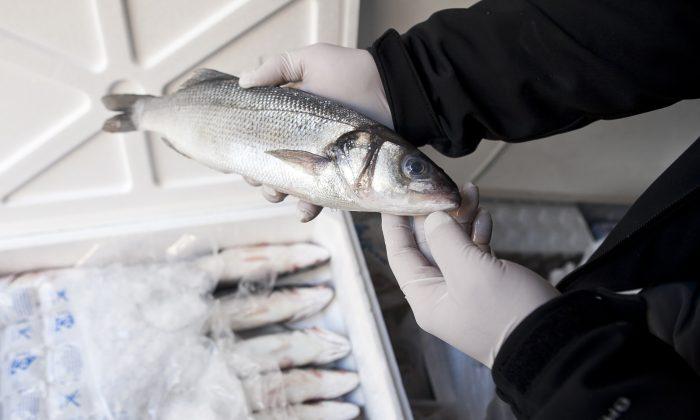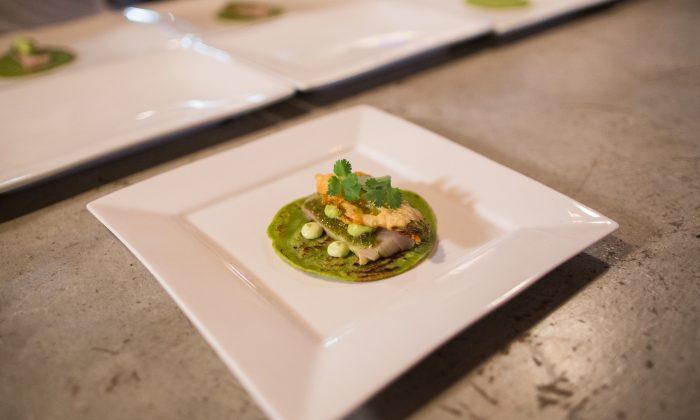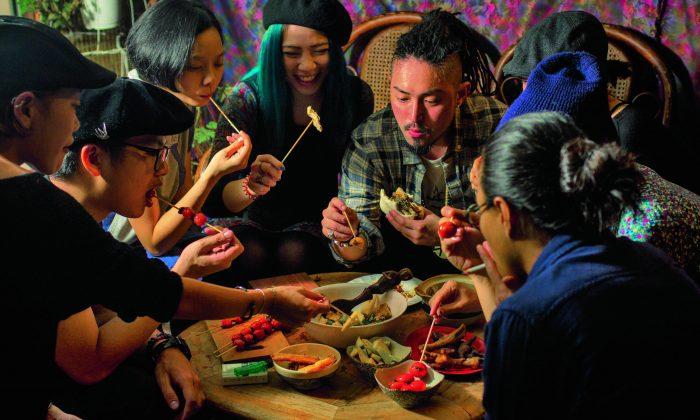When I recently asked longtime fish importer and distributor Patricio Osses about fish that are underrated and deserve to be known better, he mentioned porgy.
“You know why people don’t like it? Porgy doesn’t have a lot of meat, it has a lot of small bones,” said Osses.
It seems you can tell a lot about a person from the kind of fish on their plate. And with porgy, the patient are rewarded, and the impatient miss out.
“With a fish, you cannot go, AAAGGGH, devour it. You don’t do that.” Then he relents. He says an exception might be salmon, neatly and easily boned before it gets to the plate.
He is enthusiastic about black sea bass, and the domestic sea trout, whose season starts in spring time. In fact, give Osses a whole fish any day, and he'll gladly make it a meal.
A Dish to Remember Forever
The designated fish cook in his family, Osses prefers most of all to cook fish on a charcoal grill, whipping up a salsa with garlic, onions, and cilantro, with a touch of lemon or vinegar. He loves Spanish mackerel or sardines on the grill. As for the mild, sweet, white-fleshed merluza, a fish he likens to hake or whiting with firmer flesh, he prefers it cocido (boiled) over a la romana (fried).
When he makes merluza at home, he serves it with boiled potatoes and peas, and drizzled with an aromatic olive oil.
“If you have that dish, you'll remember it forever. It’s simple but good,” he said.
But one caveat: with this method, the fish must be fresh, he cautioned. “If not, it will smell fishy—and fish is not supposed to be fishy. It’s supposed to smell like a fish but with a sweet smell.”
“That’s a concept that a lot of people have: ‘I don’t want to eat any fish. You know why? Because I think fish smells so bad and taste so bad.’ That’s unfortunate because they’re eating fish that is very old.”
He said that in some countries in Central or Latin America, fish is mostly fried. “They like it like that. And then it has to have a fishy taste, it has to be a little old, so when it’s fried it has that special taste they’re looking for.”
“Not for me,” he added. “I like the fish to be as fresh as possible. It has to be sweet, nutty sometimes. That’s the beauty of fish. They have so many different flavors … You can prepare it this way, that way, raw, with olive oil on top, lemon on top, salt, it all makes it taste different.”
Osses, 48, runs a one-man operation, Pacific Specialties. In his own words, he is “the first hand that touches the fish. After the fisherman, it’s going to be me.”
Osses has two jobs: as fish importer who sells to wholesalers, fish markets, and some restaurants, and as a buyer for a few restaurants, for which he'll get up early to buy the fish or shellfish they require for the day, if he doesn’t already have it.
He brings in fish from different parts of the world, including his native Chile, where he mostly deals directly with the fishing boats, via his 73-year-old father, who keeps an eye out for interesting catch.
Many years ago, his father saw a fish that he thought New Yorkers would like, a white-fleshed fish. When the younger Osses opened up the package, he found himself staring at a 50-pound fish and called his father.
“Dad, what am I going to do with a 50-pound fish?” he said.
“You told me to send it. I sent it to you,” his father replied.
“I didn’t know what it was, I had never seen it,” said Osses. He brought it to the restaurant Solera, now one of his long-time clients. The chef declined. Osses pleaded, “Please come outside and take a look at it. It’s beautiful.”
The chef came out, touched the fish, and asked to take a piece to cook it.
“He was nice enough to take it from the tail … He brought it downstairs, he cooked it. I was waiting outside. All of a sudden, I see four guys coming out, ‘Where’s the fish?’ They took it in,” he said.
That fish was Chilean sea bass, and Osses was one of the first few to bring it in. But he didn’t pursue trying to import it. He could not afford buying it in large quantities.
Among some of his Chilean findings were the volcano-like picoroco and mussels the size of shoes.
Beginnings
Times were tough at the start. At the lowest of lows, Osses lived in a garage for a few months.
He had ended up in New York trying to help his father’s wholesale fish business—which dealt in impossibly huge quantities of fish to sell to fish markets and fish vendors. “My father would say [to his suppliers], I need 1,000 pounds. ‘No, we’re going to send you 5,000. Don’t worry about the price.’ It was always this constant push to move more fish and my father had his hands full.”
One week, Osses and his father had to move 92,000 pounds of swordfish. “There was no time for sleeping, we had no time for food, for breakfast, nothing. We had to sell, sell, sell. When I saw that and I saw the pressure, I always thought of doing this in the future, but differently, in a more manageable way,” he said.
In the end, his father ended up having to close his company—he kept dealing with clients who didn’t pay him—and returned to Chile.
Osses stayed behind. Things weren’t going well, and he bunked in a garage. But he couldn’t face going back to Chile. “Maybe I was too proud to go back,” he said. For him, it would have been like admitting defeat.
Osses started his own company in 1988, to focus on the same business, at a much smaller scale, selling to restaurants.
It was through a friend’s initial loan of $400 that he was able to build it up.
A Break
One day in 1999, while driving, he saw the restaurant Oceana. He managed to get an appointment with then-chef Rick Moonen two months later, after the renovation of the kitchen was finished.
“I told everybody in Chile, listen, this is my chance, send me all the weird fish you can send me. Send me all the weird stuff you have, stuff that you cannot find here,” Osses said. He showed up two months later with a truckload of fish.
Moonen, he recalled, was in an irritable mood. He'd had some sort of car issue and was late for a lunch he had to put together. Osses was turned away but was undeterred, “Excuse me, but I have a truck outside, full of fish that I just brought for his meeting. So I can wait,” he said.
When Moonen came out to take a look at the fish later, Osses told him he had “fish nobody else has here, that nobody has seen.” Osses was saying this to the chef of a seafood restaurant, so to prove himself, he brought out his Chilean fish from merluza and reineta to mussels the size of shoes.
Moonen’s curiosity was piqued. He asked what things were, envisioning dishes he could make with them, like a paella made with those huge mussels, served in the shell. He told Osses he was expecting an important guest that night and would give him some of the fish.
The guest turned out to be William Grimes from The New York Times, whose ensuing story about Osses’s unusual fish and shellfish resulted in inquiries left and right.
He acquired more clients, although he hasn’t aggressively expanded his business. He’s focused on getting the best fish possible for his current restaurant clients, among them Solera and The Four Seasons in Manhattan.
“For me, selling fish is not like a business. It’s more than that. It’s like an art. For me, if I sell you something, and you’re happy, it makes me happy, you know?” he said. “Because for me, it’s my reputation. You didn’t like it? My fault.”
It’s been years since he started waking up in the wee hours of the morning to head to the fish market. When it’s cold, his hands become dry and cracked.
There are days when he wonders if he shouldn’t be making different use of his skills and the massive knowledge he’s acquired over time. Though he doesn’t claim to be an expert, he’s the go-to guy for whenever others in the industry have questions about fish.
Another reason that he kept his business small-scale was so he would have enough time to focus on his family. When he got married, his wife put an end to his 20-hour working days, something he had come to see as completely normal. She reclaimed his weekends.
“That’s why, maybe, I haven’t been growing that much. For me it’s important to have that balance,” he said. His son Felipe’s tennis career is blooming, a result of Osses’s nurturing and coaching over the years.
“For me that is more than selling fish,” he said.
Wild Turbot
From the northwestern ocean waters of France, off the coast of Brittany, in season now until March–April:
You can buy farm-raised but it’s not the same. First of all, it’s thinner, doesn’t have a lot of meat, and the meat is a little tough.
Turbot is a fish that you have to have roasted whole because the bones, the bone marrow, when the fish is cooked is expressed through the meat, it gives it a totally different taste. A lot of places make it fillet. and I think that’s a big mistake because you’re losing all of that.
The little fins those are the best, there’s a lot of bones in there, but they’re not sharp bones. So you have to have the patience of eating or sucking. That’s maybe the best part of the fish, it has a lot of gelatin. If you roast it, it will be a little crunchy and gelatinous at the same time. The flavor is very intense. That transmits to the flesh if it’s the whole fish.
It would be maybe $85 wholesale for that fish.
Normally a restaurant tries to do three times the value. Imagine $200 dollars for one fish. But if you cook it right, it’s worth all the money.
Choros Zapatos, or “Shoe Mussels”
The shoe-sized mussels will be a very intense flavor, brinier—much brinier than here. It has a distinctive mussels flavor. Here they’re very flat to our taste, they’re mussels yes, but they don’t have a strong taste compared to Galicia for example. The mussels there are incredible. They’re very yellow and you can taste the sea, the salt.
Picorocos
Picorocos from Chile look like little red volcanos. The picorocos, I'd say, are strange because of their flavor—it’s like a crab but at the same time it has a scallopy taste. And at the same time it has a tuna taste, so it very, very unique. The broth is like water from the ocean. [Chef] Ken Oringer for example, he used to cook them first, and split them right down the middle, and have two weird-looking shells, he would make a salad [with lobster, crabmeat, and picorocos] on top of the shells and serve it like that.
Tips on Choosing Fish
- Always choose a whole fish. It will tell you much more. You can see the eyes and how firm it is.
- If the eyes pop out, that’s good. If the eyes are sunken in, that will tell you the fish is old.
- It’s hard to choose based on eye clarity because sometimes the ice will make the eyes a little foggy, making the fish seem old.
- Sometimes it’s 15 days since fish in supermarkets got fished.
- If a fish has a fishy smell it has been somewhere for a long time and it’s not a good fish to eat. Fish has to smell sweet. If you buy salmon for example, it has to have a cucumber smell but not too strong.
- If you look at salmon at a supermarket, sometimes the meat looks like it’s stitched or woven together in an unnatural way—like somebody bent the fish. It’s not all tight. Once you see that in salmon, don’t bother buying it.
- Checking the gills can also be misleading. For example, striped bass is very bloody so people put that blood on the gills to make them look nice and fresh.
- People do so many things… they will throw chlorine on the fish to wash it—because it’s cheap—and then sell it.






Friends Read Free